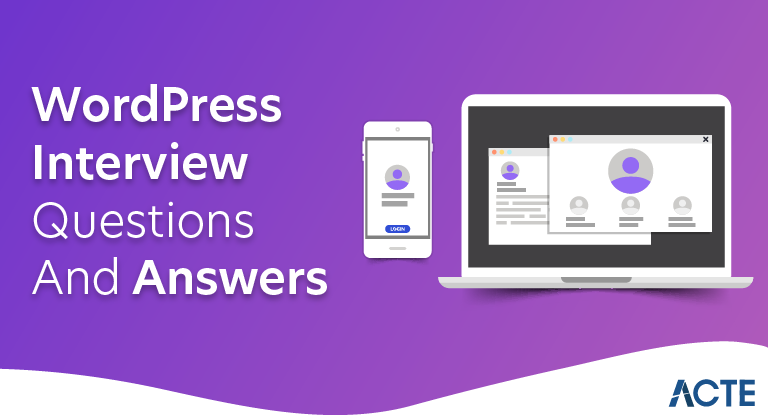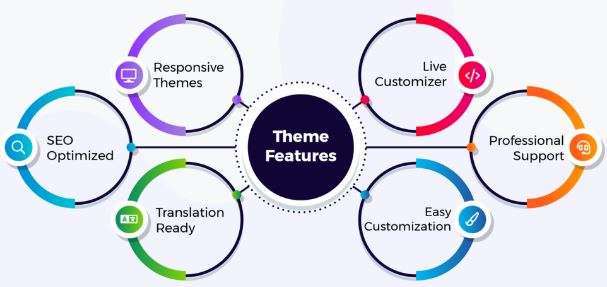
An open-source content management system (CMS) is WordPress. Since then, it has developed into a flexible platform that powers a sizable percentage of websites. Its strong ecosystem of themes and plugins, numerous customization possibilities, and user-friendly interface are the main factors that contribute to its broad appeal. Users don’t need sophisticated technical knowledge to generate and maintain content because to its user-friendly interface. The versatility of the platform is increased by the usage of themes, which let users easily alter the look and feel of their websites.
1. What is WordPress?
Ans:
In WordPress, posts are dynamic content entries displayed in reverse chronological order on the blog’s front page. They are used for regularly updated content. On the other hand, pages are static and are typically used for timeless content like About Us, Contact, etc. Pages don’t have a time stamp, and they are not part of the chronological blog post flow.
2. Explain the role of hooks in WordPress.
Ans:
Hooks in WordPress are a way to customize and extend the functionality of the platform. Actions and filters are two types of hooks. Actions allow developers to execute custom code at specific points in the WordPress execution process, while filters modify data before it is displayed or saved. Actions are like do-this-now events, and filters are like modify-this-data events.
3. How do you troubleshoot a “White Screen of Death” (WSOD) issue in WordPress?
Ans:
When encountering a “White Screen of Death” (WSOD) issue in WordPress, it typically indicates a fatal error that prevents the site from loading properly. To troubleshoot this issue, developers can start by enabling WordPress debugging to identify the specific error message causing the problem. This can be done by editing the ‘wp-config.php’ file and setting ‘WP_DEBUG’ to true. Common causes of WSOD include plugin conflicts, theme issues, exhausted memory limits, or syntax errors in theme or plugin files.
4. What is the purpose of the WordPress functions.php file in a theme?
Ans:
- Manages theme functions and features.
- Executes code snippets during theme initialization.
- Enables customization without modifying core files.
- Used for defining custom functions and hooks.
- Central location for theme-related code.
5. Explain the concept of WordPress hooks and their significance.
Ans:
- Hooks are events triggering custom functionality.
- Facilitate customization without modifying core code.
- Two types: actions (tasks at specific points) and filters (modify data).
- Essential for theme and plugin development.
- Enhance modularity and code extensibility.
6. What is the purpose of the wp_query object in WordPress?
Ans:
The wp_query object is a powerful tool in WordPress used to retrieve content from the database based on specified parameters. It is the primary mechanism for querying posts and pages, allowing developers to customize queries for different scenarios. By manipulating the wp_query object, developers can control what content is displayed on a page, archive, or custom template.
7. How can you improve the performance of a WordPress site?
Ans:
- Use a caching plugin to store static copies of web pages for faster loading.
- Optimize images and use lazy loading to reduce page load times.
- Minify CSS and JavaScript files to reduce file sizes.
- Enable browser caching to store resources locally on users’ devices.
8. How does WordPress handle post revisions, and what impact can it have on a site?
Ans:
- WordPress saves post revisions automatically.
- Stored in the database for each post.
- Ensures version history and content recovery.
- Can impact database size with numerous revisions.
- Limit revisions or use plugins for control.
9. Explain the purpose of the WordPress database and how it is structured.
Ans:
The WordPress database stores all the content, settings, and configurations of a WordPress site. It is structured with several tables that store information about posts, pages, users, comments, and more. Each table corresponds to a specific type of data, and relationships between tables are established using keys. Understanding the database structure is crucial for developers when creating custom queries or modifying data directly.
10. Describe the difference between tags and categories in WordPress.
Ans:
| Feature | Categories | Tags | |
| Hierarchy |
Hierarchical (Parent-Child Relationships) |
Non-hierarchical (Independent) | |
| Purpose | Primary Content Organization, Site Structure | Detailed Descriptions, Content Attributes | |
| Scope | Broader, Encompassing Multiple Topics | Narrower, Specific Details or Characteristics | |
| Number of Use |
Typically Fewer, Represent Main Site Sections |
Can Be Numerous, Represent Specific Attributes |
11. Explain the purpose of WordPress taxonomies and provide examples.
Ans:
- Taxonomies classify and organize content.
- Categories and tags are primary taxonomies.
- Allow grouping and categorization of content.
- Enhance content organization and navigation.
- Custom taxonomies extend classification options.
12. Explain the difference between posts and pages in WordPress.
Ans:
Posts: Posts are entries listed in reverse chronological order on your blog’s homepage. They are typically used for time-sensitive content such as news updates, articles, or blog posts.
Pages: Pages are static, standalone pieces of content. They are not listed by date or in the blog’s chronological flow. Pages are often used for timeless content such as an About page, Contact page, or Privacy Policy.
13. How can you improve WordPress site performance through caching?
Ans:
- Caching stores static copies of dynamic content.
- Reduces server load and speeds up page loading.
- Utilizes plugins like W3 Total Cache or WP Super Cache.
- Supports browser caching for repeat visits.
- Enhances overall site speed and user experience.
14. Describe the purpose of transients in WordPress and their benefits.
Ans:
- Transients store temporary data in WordPress.
- Used for caching to reduce database queries.
- Include an expiration time for data refresh.
- Accessed using get_transient() and set_transient().
- Enhances performance by minimizing server load.
15. What is the role of the .pot file in WordPress theme or plugin development?
Ans:
The .pot (Portable Object Template) file in WordPress development is a template for translating text strings into different languages. It contains all the translatable strings from the theme or plugin. Developers generate the .pot file using tools like Poedit. Translators use this file to create .po (Portable Object) and .mo (Machine Object) files for specific languages. These files are then loaded to display the theme or plugin in the user’s preferred language.
16. What is the significance of the wp-config.php file?
Ans:
- The wp-config.php file contains essential configuration settings for a WordPress site.
- It includes database connection details, security keys, debugging settings, and other site-specific configurations.
- Modifying this file is critical for altering core settings and configuring various aspects of WordPress.
17. What is the role of themes in WordPress?
Ans:
- Themes in WordPress determine the overall design, layout, and style of a website.
- They control the presentation of content, including the arrangement of elements, color schemes, and typography.

18. What are custom post types, and how can they be registered in WordPress?
Ans:
- Custom post types extend beyond default posts and pages.
- Registered using register_post_type() function.
- Support labels, features, and taxonomies.
- Ideal for specialized content organization.
- Enhance content diversity and presentation.
19. How can you create a child theme in WordPress, and why is it beneficial?
Ans:
- Create a new directory in wp-content/themes/.
- Include a style.css file referencing the parent theme.
- Activate the child theme in the WordPress admin.
- Customize templates without altering the parent theme.
- Safeguards modifications during parent theme updates.
20. How do you implement a responsive design in a WordPress theme?
Ans:
To implement a responsive design in a WordPress theme, use CSS media queries to adjust layout and styles based on screen size. Ensure images are responsive by setting their maximum width to 100%. Utilize flexible grid systems like Flexbox or CSS Grid for layout. Test the theme on various devices and screen sizes to ensure responsiveness. Consider using frameworks like Bootstrap or Foundation for responsive design elements and components.
21. Explain the role of the REST API in WordPress and how it can be utilized.
Ans:
The REST API in WordPress allows developers to interact with the content of a site programmatically using standard HTTP requests. It provides a way to retrieve, create, update, or delete content remotely. Developers can use the REST API to integrate WordPress with external applications, create headless WordPress setups, or build custom interfaces for managing content.
22. What is the significance of the WordPress Customizer, and how can it be utilized?
Ans:
- Visual interface for real-time theme customization.
- Allows preview and modification of theme settings.
- Commonly used for site identity, colors, and fonts.
- Enhances user experience in theme personalization.
- Customizer settings can be extended by themes.
23. Explain the role of the .htaccess file in WordPress and its use cases.
Ans:
- Configuration file for Apache servers.
- Controls server behavior and directory configurations.
- Essential for WordPress permalinks and URL redirection.
- Enhances security with access control rules.
- Located in the site’s root directory.
24. How can you create a custom page template in WordPress?
Ans:
To create a custom page template in WordPress, developers need to create a new PHP file in their theme folder and add a specific header comment. This comment includes Template Name, which is the name of the template that will be displayed in the WordPress admin. Once the template file is created, it can be selected when creating or editing a page in the WordPress admin.
25. Describe the purpose of the WordPress REST API and its applications.
Ans:
- WordPress REST API exposes site data in JSON format.
- Enables external applications to interact with WordPress.
- Supports CRUD operations (Create, Read, Update, Delete).
- Facilitates decoupled or headless WordPress setups.
- Enhances content consumption and presentation.
26. How does WordPress handle image optimization, and what techniques can be employed?
Ans:
- WordPress generates various image sizes on upload.
- Users can choose appropriate sizes when inserting images.
- Compress images without compromising quality.
- Implement lazy loading for deferred image loading.
- Leverage image optimization plugins for efficiency.
27. What is the purpose of shortcodes in WordPress, and how can they be created?
Ans:
- Shortcodes are placeholders enclosed in square brackets.
- Facilitate embedding dynamic content or functions.
- Enable users to add features without extensive coding.
- Created using add_shortcode() with defined functionality.
- Users can incorporate shortcodes into posts or pages.
28. What is the significance of the wp_head and wp_footer hooks in WordPress themes?
Ans:
The wp_head and wp_footer hooks are essential in WordPress themes for injecting code or scripts into the head and footer sections of a web page. Developers often use these hooks to add custom stylesheets, scripts, or meta tags. They play a crucial role in integrating external resources, such as analytics or social media scripts, into a WordPress site.
29. How can you create a custom widget in WordPress?
Ans:
Creating a custom widget in WordPress involves defining a new class that extends the WP_Widget class. This class should include methods for widget creation, updating, and rendering. Once the widget class is defined, it can be registered using the register_widget function. After registration, the widget becomes available in the WordPress admin, allowing users to add it to widget areas through the Appearance > Widgets section.
30. How can you secure a WordPress site, and what are best practices?
Ans:
- Keep themes, plugins, and core updated regularly.
- Utilize strong passwords and enforce policies.
- Implement two-factor authentication for added security.
- Limit login attempts to prevent brute force attacks.
- Conduct regular security audits and backups.
31. How can you implement internationalization (i18n) in a WordPress theme?
Ans:
- Start by internationalizing your theme using the ‘__(‘text’, ‘text-domain’)’ function for strings.
- Replace hardcoded text with this function throughout your theme files.
- Create a language translation file (.po/.mo) using tools like Poedit.
- Translate strings into different languages and save the files with appropriate language codes.
- Load the translated text domain in your theme’s functions.php file using the ‘load_theme_textdomain()’ function.
32. Explain the purpose of nonce in WordPress and how it enhances security.
Ans:
Nonce, which stands for “number used once,” is a security feature in WordPress used to protect against unauthorized actions or requests. Nonces are unique tokens generated for a specific action and are typically included in forms or URLs. They ensure that actions, such as form submissions or AJAX requests, are legitimate and originated from the same site, preventing unauthorized access or manipulation.
33. Describe the role of the Child Theme in WordPress.
Ans:
A Child Theme in WordPress is a theme that inherits the styles and functionality of another theme called the parent theme. It allows developers to make modifications to the design and functionality without altering the original theme files. This is essential to preserve customizations when the parent theme receives updates. By creating a child theme, developers can safely add custom styles, templates, and functions without affecting the parent theme.
34. What is the significance of the WordPress nonce, and how is it used for security?
Ans:
- Nonce stands for “number used once.”
- Ensures the security of actions and forms in WordPress.
- Prevents unauthorized access to sensitive operations.
- Generated using wp_nonce_field() or wp_create_nonce().
- Validates the origin and intent of requests.
35. Explain the concept of custom post formats in WordPress.
Ans:
Custom post formats in WordPress allow developers to define different formats for displaying posts, such as video, audio, gallery, quote, etc. Each format may have its styling and layout. Users can choose the appropriate format when creating or editing posts. Themes can then apply specific styles and functionality based on the selected post format, enhancing the presentation of different types of content.
36. How can you create a custom post type in WordPress, and why might you need to do so?
Ans:
Creating a custom post type in WordPress involves using the register_post_type function. Developers can define various parameters, including labels, capabilities, and taxonomies, to tailor the post type to specific content needs. Custom post types are useful when dealing with content that doesn’t fit the default post or page structure, such as portfolios, testimonials, or products.
37. Explain the concept of taxonomies in WordPress and provide examples.
Ans:
Taxonomies in WordPress are a way to group and organize content. The two main types are categories and tags. Categories create a hierarchical structure, while tags are more flexible and non-hierarchical. Developers can also create custom taxonomies to classify content further. For example, a website about books might have taxonomies like “Genres” or “Authors” to categorize and filter content more precisely.
38. How can you troubleshoot common issues in WordPress?
Ans:
Troubleshooting in WordPress involves identifying and resolving issues that may arise during development or site maintenance. Developers can use tools like the WordPress Debugging feature, error logs, and browser developer tools to diagnose problems. Disabling plugins or themes, checking for compatibility issues, and examining server logs are common techniques. Additionally, staying informed about WordPress updates and best practices helps prevent and address potential issues proactively.
39. Explain the purpose of the WordPress wp_head() function.
Ans:
- Outputs essential elements in the document head.
- Includes stylesheets, scripts, and meta tags.
- Necessary for theme and plugin functionality.
- Allows developers to add custom elements.
- Ensures proper document structure and styling.
40. What are mu-plugins in WordPress, and how do they differ from regular plugins?
Ans:
- Must-use plugins (mu-plugins) are automatically activated.
- Placed in the wp-content/mu-plugins directory.
- Suitable for essential functionality across sites.
- Cannot be deactivated from the WordPress admin.
- Ideal for functionality shared by multiple sites in a network.
41. Describe the purpose and usage of WordPress custom fields.
Ans:
WordPress custom fields provide a way to add additional data to posts, pages, or custom post types. They are often used to store and display extra information like author bio or product details. Custom fields are implemented using functions like get_post_meta() and update_post_meta(). In a theme, you can integrate them by editing the template files, while in a plugin, custom fields can be added programmatically using actions like save_post to ensure data integrity.
42. What is the role of the register_activation_hook function in WordPress plugins?
Ans:
The register_activation_hook function in WordPress plugins is utilized to execute code when the plugin is activated. This is crucial for performing one-time setup tasks, like creating database tables or initializing default settings. Developers define a function to be executed upon activation and then register it using register_activation_hook(__FILE__, ‘your_activation_function’). This ensures that the specified function is triggered only when the plugin is activated, streamlining the setup process.
43. Explain the concept of the WordPress Rewrite API.
Ans:
The WordPress Rewrite API allows developers to create custom URL structures for permalinks. By utilizing functions like add_rewrite_rule and add_rewrite_tag, developers can define custom URL patterns and rewrite rules. For example, a developer might use this API to create SEO-friendly URLs for a custom post type or implement a complex URL structure for a specific section of the site. The Rewrite API provides flexibility in defining URL patterns beyond the default WordPress permalink structure.
44. Describe the role of the WordPress register_sidebar() function.
Ans:
- register_sidebar() defines and registers widgetized areas.
- Allows customization of sidebars for different layouts.
- Supports multiple widget areas for flexibility.
- Enhances theme versatility and user customization.
- Ensures consistent widget management.
45. What security considerations are relevant to passwords?
Ans:
- WordPress uses cookies and hashed user credentials for authentication.
- Cookies maintain persistent login sessions.
- Hashed passwords are stored in the database.
- Security considerations include strong password policies.
- Passwords should be hashed using secure algorithms.
46. What is the purpose of the is_page_template() function in WordPress?
Ans:
The is_page_template() function in WordPress allows developers to check if a specific page template is being used. This is valuable for conditional loading of scripts or styles based on the template in use. By incorporating this function within the theme’s functions.php file, developers can enqueue scripts or styles selectively, enhancing performance by loading only the necessary assets for a particular page template, optimizing the user experience.
47. Describe the significance of the WordPress Heartbeat API.
Ans:
The WordPress Heartbeat API is responsible for managing real-time data communication between the browser and the server. It can be beneficial for collaborative editing features, notifications, or dynamic content updates. However, excessive usage can impact server resources. Developers should be mindful of the frequency and purpose of Heartbeat API requests to prevent unnecessary server load. Customizations, like adjusting the frequency or selectively disabling the API on specific pages, can be implemented to ensure optimal performance.
48. What are transients in WordPress, and how can they be utilized for performance optimization?
Ans:
- Transients store temporary data with expiration times.
- Used for caching to reduce database queries.
- Accessed using get_transient() and set_transient().
- Enhances site performance by minimizing server load.
- Ideal for storing data with limited relevance.
49. Explain the purpose of the WordPress wp_footer() function.
Ans:
- Outputs essential elements before the closing






